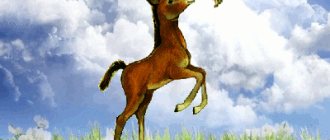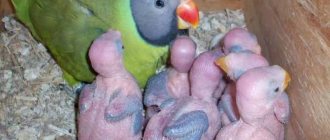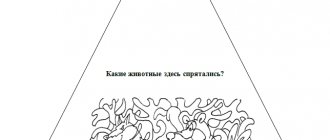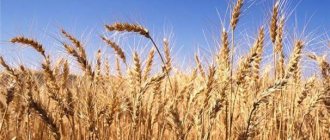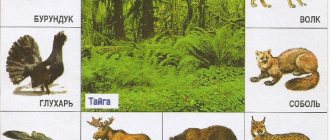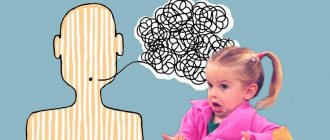Abstract of GCD for children of senior preschool age (preparatory group). On the farm
Summary of direct educational activities with children of the preparatory group with OHP “On the Farm.”
Author: Pavlushko Oksana Mikhailovna Directly educational activities are designed: for teachers and parents of children of senior preschool age Goal: To consolidate and expand children’s knowledge about domestic animals and birds. Objectives: - To consolidate children's knowledge about: how a person takes care of domestic animals and birds; what benefits do they bring to humans? — Activate and enrich vocabulary on the topic. - Strengthen the ability to coordinate speech with movements, answer the teacher’s question with a complete answer. — Develop visual and auditory perception, attention, memory, curiosity and cognitive activity. — Foster a caring attitude towards the environment. Equipment: illustrations: domestic animals and birds, pens with numbers; recording of animal voices, a soft toy Cat, puzzles and pencils for each child, a cap - a Cat mask, the game “The Benefits of Pets”, a laptop, a ball.
The course of direct educational activities. Educator. Today I invite you on a journey into the world of animals and birds. We will learn a lot of interesting things, but first we will find out who we are talking about. (a phonogram with the voices of animals sounds, children name those animals and birds they recognize) Educator. Well done, they recognized all the animals and birds. How can all these birds and animals be called in one word? (domestic) Educator. That's right, these are poultry and animals. Why are they called pets? (they live next to a person, the person builds a home for them, keeps the home clean, feeds birds and animals). Educator. So we will remember how a person cares for domestic animals and birds, and what benefits they bring to humans. Educator. Our animals and birds are lost, let's help them and find their own home for each, name it and say who takes care of this animal or bird. (children take turns taking the figures and telling the story).
The cow lives in a barn and is taken care of by a milkmaid. The horse lives in a stable and is taken care of by a groom. The dog lives in a kennel and is taken care of by its owner. The pig lives in a pigsty and is taken care of by a pig farmer. The cat lives wherever it wants, its owner takes care of it. The sheep lives in a sheepfold and is taken care of by a shepherd. The chicken lives in a chicken coop and is taken care of by a poultry woman. The goose and duck live in the poultry house and are looked after by the poultry woman.
Educator. Well done! You did a very good job. Educator. Now we were talking about a farm where many animals and birds live. If the farm is small, then the animals live in a barn, in different stalls. And the birds are in the aviary. And the owner and mistress look after them.
Educator. Do you know how animals voice? Playing with a ball (cow - moos, horse - neighs, pig - grunts, sheep - bleats, cat - meows, dog - barks, goat - meows, rooster - crows, duck - quacks, goose - cackles, turkey - chatters, chicken - beeps). Educator. It's time to send our animals and birds to the pens (a place in the pasture, enclosed by a fence, intended for rest and additional feeding), as the veterinarian will soon come to examine the animals. Educator. What does a veterinarian do? (monitors the health of animals and birds, gives them vaccinations, prescribes vitamins, treats them) Educator. Now you will be shepherdesses. You choose an animal or bird, clearly pronounce its name, dividing it into syllables. If the name has one syllable, then put it in the first paddock, if there are two syllables - in the second, if three - in the third (1 paddock - goose, bull, horse; 2 paddock - rabbit, goat, ram, sheep; 3 paddock - dog, cow).
Educator. Well done, everything is in its place. For a minute, all the guys turned into foals (the children perform movements in accordance with the words)
To begin with, they stretched, stretched, smiled, turned to the right, turned to the left.
All the horses shook their manes and waved their tails playfully. And they beat with their hooves: one and two, and three, four. One and two and three and four. Have you rested or played? Aren't you a little tired? Great, everyone sat down and looked at me. Educator. One pet hid, to find it you need to solve a puzzle. We will write down the first letters of words - pictures and solve the puzzle.
(children take turns writing letters and reading the word together. The teacher takes out a cat toy).
Educator. Cats have lived next to humans for thousands of years. But to this day she remains a largely mysterious creature. At different times, in different countries they treated it differently. In ancient Egypt, the cat was idolized and given various honors. Accidental killing of cats was punishable by a heavy fine. If the cat died, it was mourned and showered with gifts - in the form of dried mice. This was done because the Egyptians believed that in the other world a person or animal continued to live (the story is accompanied by a display of pictures on the laptop) Educator. What is an affectionate name for a cat? Educator. Yes. Kitty. Kisonka - Murysonka. Our Kisonka will be..... (children stand in a semicircle, in the center is Kisonka, with a hat-mask on her head. A scene is played out based on the joke “Kisonka - Murysonka”)
- Kitty-Murysonka, where have you been? - At the mill. - Little kitty little mouse, what was she doing there? — I ground flour. - Little kitty, what kind of flour did you bake with? - Gingerbread cookies. - Little kitty, with whom did you eat gingerbread? - One. - Don't eat alone! Don't eat alone!
Educator. Well done. It turned out to be a small performance. Educator. One day, domestic animals and birds gathered in a barnyard and began to argue which of them was needed more by man. Let's look at what benefits each pet and bird brings? Game “Benefits of Pets” (children take any picture of a pet and match it with the corresponding pictures: cow - milk, meat,...... Talk about the benefits of the selected animal or bird)
Educator. Well done. Everyone completed the task. Who were we talking about today? What do we know about domestic animals and birds? (pets and birds live next to a person, he takes care of them: he builds them a home, feeds them, gives them vitamins, cleans them, and animals benefit people - they give milk, eggs, meat, feathers, wool, skin, and protect the house)
.
Educator. If you think that you have completed all the tasks, go through it like a cat, and if you made mistakes, go through it like a kid.
We recommend watching:
Summary of educational activities in the preparatory group on familiarization with the environment "Air and its properties" Summary of educational activities in the preparatory group "Journey to the North" Summary of educational activities for children of the preparatory group "Types of transport" Summary of cognitive activities in the preparatory group on the topic " Reservoirs"
Similar articles:
Summary of a lesson in the preparatory group on the topic: Rules of conduct in kindergarten
Life safety lesson “Rules of safe behavior on water.” Preparatory group
Leave your comment
Gift certificates
Samara students will be taught by a robot
Reading time: 1 minute
Scientists make protein-shaped gummies to help blind children learn chemistry
Reading time: 2 minutes
The procedure for holding the All-Russian competition “Teacher of the Year in Russia” in 2021 has been approved
Reading time: 3 minutes
Every third student is behind in school
Reading time: 3 minutes
An Italian teacher gave children a summer assignment and became famous
Reading time: 4 minutes
Chinese University Enrolls Artificial Intelligence in Computer Science Faculty
Reading time: 1 minute
Responsibility for resolving any controversial issues regarding the materials themselves and their contents is taken by the users who posted the material on the site. However, the site administration is ready to provide all possible support in resolving any issues related to the work and content of the site. If you notice that materials are being used illegally on this site, please notify the site administration using the feedback form.
All materials posted on the site were created by the authors of the site or posted by users of the site and are presented on the site for informational purposes only. Copyrights for materials belong to their legal authors. Partial or complete copying of site materials without written permission from the site administration is prohibited! The opinion of the administration may not coincide with the point of view of the authors.
Source
Lesson summary for the preparatory group Wild animals.
ECD for familiarization with the outside world in the senior group “Wild animals in autumn, their young”
Wild animals in autumn
, their
cubs
.
Objectives: 1. To concretize and expand children’s ideas about wild animals in the fall
,
about preparing animals for wintering: changing the color and nature of the coat, insulation
housing, hibernation, preparing food supplies for the winter.
Introduce the names of the babies
,
animal
, food.
2. Correct the cognitive sphere
, develop objectivity of perception (recognition and discrimination
of animals by contour
, shadow and noisy images)
Shape
auditory and visual perception,
children's
, thinking through didactic games.
3. To develop the ability to listen to the answers of comrades and interest in the lesson.
Progress of the lesson:
1. Organizational moment.
Report from the duty officer on the nature calendar (children name the season, month, day of the week)
. We mark it in the nature calendar.
2. Repetition of what has been covered.
- What kind of domestic animals do you know?
?
(cow, horse, sheep, pig)
- Why can they be called animals
?
(the body is covered with hair, they have 4 paws or legs, a torso, a muzzle, a tail, they feed their young with milk
)
- Why do we call them pets? (they live next to a person, he takes care of them)
3. Communicate the goals and topics of the lesson.
- Today we will go with you to the forest and get acquainted with those animals
who live in the forest.
We will learn to name them, distinguish them, find out what they eat, what their cubs
and how they prepare for winter.
4. New material.
a) Introductory conversation.
(Slide show – picture of autumn , general background)
Autumn
in the forest it establishes its order: the leaves turn yellow, the grasses dry, the flowers wither.
And the animals
that live in the forest know that it’s getting cooler outside and it’s time for them to prepare for winter: insulate their burrows,
“change their coats
,” and stock up.
(2 slide – wild animals )
Wild animals live on their own in the forest
: wolf, fox, bear, squirrel, hare, hedgehog.
They take care of themselves, build their own homes, take care of their young
, which is why we call them
wild animals or beasts
.
(3 slide – parts of the bear’s body)
Animals have a head
, body, paws, tail.
The body is covered with hair or needles. These animals feed their young with milk
. Some of them are predators: wolf, fox, bear, while others love plant foods: squirrel, hare.
b) Explanation of the material (teacher’s story about different animals
with slide demonstration: appearance of
the animal
, habitat, food and
cubs
)
(4 slide – bear)
The largest animal
, which lives in our forests in the Urals, is a brown bear.
He has thick fur, a huge body, a large head, and strong paws. He needs all this in order to survive in the forest. He loves to eat. The bear eats everything: delicious berries - raspberries, picks them directly with twigs and puts them in his mouth, mushrooms, honey, can fish, collect tasty roots. And by the time autumn arrives, he eats up
to accumulate more fat.
Fat accumulates under the skin. At the end of autumn,
the bear digs a den for itself, covers it with leaves and goes to bed. Due to subcutaneous fat, he does not freeze in winter and does not want to eat. In the spring, a small bear cub is born in his den. The bear is considered clumsy, but it is not. The bear deftly climbs trees and can swim.
Lesson on familiarization with the surrounding world “Pets” (senior group)
Tatyana Fedoseeva
Lesson on familiarization with the surrounding world “Pets” (senior group)
Goal: Expanding, clarifying and systematizing knowledge about domestic animals .
— expand children’s knowledge about the world around them , clarify their ideas about domestic animals ;
- to consolidate the practical skill of forming and using nouns with diminutive suffixes;
- teach children to classify objects according to essential characteristics; form generalizing concepts ;
-learn to make proposals on issues;
- train children in the correct use of prepositional case constructions;
- develop logical thinking;
- develop auditory attention, memory, imagination;
- develop speech activity and communication skills;
- cultivate emotional sensitivity;
- to form such moral qualities as willingness to help, goodwill.
— to cultivate a caring attitude towards living nature , cognitive interest in the surrounding world .
Equipment: tape recorder and audio recording with the voices of pets , a model of a barnyard, object pictures, pet toys .
Scientific and encyclopedic training of a teacher:
— Program for the development and education of children in kindergarten “Childhood”
. V. I. Loginova, T. I. Babaeva and others. St. Petersburg, 2007
— Knowledge of the animal world . M. N. Sigimova. Volgograd, 2009.
— Orthoepic dictionary of the Russian language: Pronunciation, stress, grammatical forms. S. N. Borunova, V. L. Vorontsova, N. A. Eskova. Moscow, 1989.
— Material for classes on speech development : Pets . T. I. Podrezova. Moscow, 2008.
— Dictionary of grammatical difficulties. T. F. Efremova, V. G. Kostomarov. Moscow, 1986.
Weekly calendar plan on the topic “Pets” for preschool educational institutions
Topic: "Pets"
Monday.
Morning.
1. Conduct a conversation: “Who lives in grandma’s yard?” Goal: Continue to expand and systematize children’s knowledge about pets
2. Didactic games: “Which one, which one, which one?”, “Who has it, who?” Goal: to develop speech activity.
3. Socially useful work: continue to teach how to maintain order in the group, wipe and wash toys, building materials
4. Promote cognitive development through the placement in a group of paintings from the “Pets” series, illustrations, pictures in children’s books with images of domestic animals and birds.
5. Individual conversation on the topic: “How I take care of my pet.” Goal: to systematize ideas about domestic animals.
GCD 1. Speech therapy
2. H.E.R. Modeling "
Cows
»
Program tasks:
continue to teach children the skills of sculpting sculptures using the composing technique.
consolidate the ability to sculpt cylinders of different sizes and volumes, develop imagination and creative thinking, and cultivate a love for pets. Materials and equipment
: pictures of a fox, wolf, bear, hare and cow, a sample of the finished work, a modeling board, plasticine, stacks, napkins.
Vocabulary work:
tail, horns, hooves, milkmaid.
Methodical techniques:
org. moment - a riddle, a conversation about pets, looking at a sample, showing a method of action, finger gymnastics, independent and other. work, result.
3. H.E.R. Musical
Walk.
1. Observations: about the dog (appearance, what it eats, habits).
2. Didactic games: “Guess what kind of animal” Goal: To cultivate a desire to take care of pets.
3. Labor in nature: continue to teach how to maintain order in the area. Cultivate hard work.
4. Outdoor games: “Fishing Rod”, “Horses” - Support children in their desire to provide all possible assistance to adults and peers.
5. Relay race “Be nimble” - Develop motor activity. Activate attention and memory.
6. D/game “Who gives what?” — consolidate knowledge about the benefits of pets; cultivate respect for the work of adults.
2nd floor day.
1. Listening and discussion: the fairy tales of W. Disney “The Three Little Pigs Are Resting” Purpose: to develop the ability to listen carefully and answer questions.
2. S/R: “At grandma’s in the village”, “Farm”, develop playful interaction.
3. Listening to audio recordings with the voices of pets and birds. Develop musical abilities.
4. Didactic games: “Whose mother?” - develop attention and speech activity.
5. I/ex. “Make a story” - consolidate the ability to compose a story based on a picture, invent previous and subsequent events.
Walk
1. I/u “Development of movements.” Goal: to strengthen the skills of throwing objects at a distance
2. P/i “Stork” goal: to develop balance and coordination of movements.
3. D/i “Find a pair” goal: orientation in space, response to a signal.
Tuesday.
Morning.
1. Conversation “Who lives in the yard?” Enrich children's knowledge and vocabulary through conversation.
2. D/I “Guess who I’m going to talk about?” Guessing riddles about pets.
3. Examination of subject pictures depicting domestic animals, goal: to learn to identify the family of a pet.
4. Cultural and hygienic skills: Strengthen the ability to notice and eliminate disorder in one’s appearance, tactfully inform a friend about the need to correct something in a suit or hairstyle.
GCD 1. Speech therapy
2. ETC. FEMP
"Hour. half an hour"
Program content.
Continue to learn how to independently compose and solve addition and subtraction problems, introduce them to clocks, learn to tell time using a clock, develop ideas about geometric shapes and the ability to draw them on a piece of paper, consolidate the ability to name the previous, next and missing number indicated by a number.
Material.
pictures depicting oak trees (7 pcs.), pine trees (3 pcs.), a six-headed serpent; a sheet of paper depicting geometric figures of different types and sizes (triangle, rhombus, trapezoid, rectangle, square, hexagon, pentagon - each figure is given in two sizes), cards with numbers from 0 to 20, counting sticks, cards with numbers from 1 to 20, sheets of paper with images of geometric figures of different types and sizes, a model of a clock, colored pencils, sheets of paper.
Dictionary.
Half an hour, subtraction, subtract.
Methodological techniques.
Org. moment - “Say the opposite”, game exercise “Solve the problem”, clarification of the difference between addition problems and subtraction problems, game exercise “Let’s find similar ones”, physical exercise, didactic game “Let’s find the neighbors of a number”, game exercise “Draw a pattern”, summary.
3. F.R. Physical education No. 37.
II
half.
day H.E.R. Drawing " Pets
"
Program tasks:
Learn to expressively convey images of domestic animals in a drawing (body shape, location and shape of body parts, their size, proportions) based on a diagram, choose an animal according to your desire, consolidate technical skills and abilities in drawing (mixing colors to obtain the desired shade), develop figurative perception and imagination, learn to talk about your drawings and the drawings of your comrades.
Materials:
wax crayons, animal structure diagrams, pictures of dogs, cats, cows, horses.
Vocabulary work:
graceful, claws, paws,
Methodical techniques:
org. moment - riddles about pets, looking at pictures, d/i “What does it look like”, showing how to draw, finger gymnastics, independent and ind. work, result.
Walk.
1. Observation of a dog - learn to establish a connection between the appearance features, behavior of animals and the conditions of the winter season; to cultivate interest in the life of animals, love, and the desire to help in difficult conditions.
2. Labor activity. Shoveling snow into a certain place to build ice figures teaches how to work together and achieve a goal through joint efforts.
3. Outdoor games. “We are funny guys”, “Entertainers” - learn to clearly speak the text in the game, follow the rules of the game.
4. Development of movements. Ind. Job. Goals: improve techniques for throwing objects at a horizontal target; develop eye, coordination, dexterity; develop a positive attitude towards physical exercise.
2nd floor day.
1. Reading the fairy tale “Someone else’s egg.” Write a descriptive story about a rooster and a hen. Prepare a story and create conditions for listening to it, teach retelling close to the text.
2. D/I “What kind of animal?” Develop the ability to identify animals by contour.
3. Drawing on the topic “Who lives in the yard”, develop creativity and imagination.
4. Role-playing game: “Veterinary hospital.” Create conditions and help organize the game, develop gaming skills, and the ability to interact.
5. Socially useful work: continue to teach how to maintain order in the group.
6. Individual work. D/game “What, where?” — exercise children in establishing spatial relationships between objects: in front, behind, between, next to each other.
Walk.
1. Observation of the dog. – learn to answer questions during observation.
2. I. U. “Who will throw further” - develop accuracy, eye
3. P.I. “Mousetrap” – develop motor activity
4. D. And, “Count the snowballs” - consolidate the count to 20.
5. D.I. “What has changed?” - develop attention, thinking, speech.
Wednesday.
Morning.
1. Conversation on the topic: “Where do milk rivers come from?” Goal: to consolidate knowledge about the benefits of pets; cultivate respect for the work of adults.
2. Guessing riddles about pets - develop attention and auditory memory.
3. P/game “Cat and Mice”. Teach children to act on cues.
4. Work in nature: continue to teach how to maintain order in a corner of nature. Cultivate a desire to care for plants. Support children in their desire to provide all possible assistance to adults and peers
5. Promote cognitive development through the placement in a group of paintings from the “Pets” series.
6. Ind. Job. Carry out art work. Practice drawing animal fur with a hard brush using different types of strokes - straight, wavy, rounded and vertical.
GCD 1. Speech therapy
2. S.K.R. LIFE SAFETY FUNDAMENTALS "
How to behave with animals
»
Program tasks:
provide knowledge about the rules of conduct when meeting and communicating with various domestic and stray animals, teach children to understand the condition and behavior of animals, teach careful handling of animals, explaining that contact with them can be dangerous, help children learn and remember the rules of proper handling of pets pets and stray animals, promote speech development, enrich vocabulary, develop creative thinking, improve memory, activate attention, cultivate a humane, caring attitude towards animals.
Materials:
drawings of animals, multimedia presentation, poems and riddles about animals, task cards, colored pencils.
Vocabulary work:
homeless, aggressive, rabid, owner.
Methodical techniques:
org. moment - greeting, conversation with children, riddles, reading and discussion of a poem, plastic sketch, formulation of rules of behavior with unfamiliar animals, viewing a presentation, physical exercise, d/i “Color the right pictures”, summary.
3. H.E.R. Musical
Walk.
1. Observing seasonal changes - forming ideas about changes in nature
2. Labor activity. Covering the roots of trees with snow, instilling a desire to provide assistance to living objects.
3. Outdoor games: Playing snowballs, strengthening skills in throwing objects.
4. Jumping on one leg to develop a sense of balance.
5. Individual work on movement development. Purpose: to teach self-insurance when performing balance movements.
2nd floor day.
1. Reading the fairy tale “The Wolf and the Seven Little Goats.” – remind children of the plot of a familiar fairy tale, consolidate role-playing dialogue, and develop intonation.
2. Plot-role-playing game “Family”. Develop the game idea.
3. Games with a constructor. Teach children to create buildings according to diagrams. Develop creativity.
4. Discussing the situation: “If your pet is sick.” Encourage children to care for their pets. Cultivate kindness.
5. Didactic game: “Who is screaming?” Learn to recognize animal voices.
Walk.
1. S/r game “Cat” Goal: developing the ability to take on the role of an animal.
2. Game-exercise “The cat caresses.” Goal: to promote the development of self-esteem in children
3. Computer presentation “Pets”. Goal: to teach children to name the body parts of animals, to use words in speech that convey an emotional attitude towards them. Develop empathy and coherent speech.
Thursday.
Morning.
1. Situational conversation about how a person takes care of pets. Goal: to develop coherent speech and the ability to speak out.
2. D/i. “Domestic and wild animals” Consolidate knowledge of the names and distinctive features of wild and domestic animals; be able to divide animals into groups.
3. Articulation gymnastics: “Horse” - teach children to clearly pronounce words.
4. Didactic games: “Whose mother?”, “Collect a picture” (cut-out pictures of “pets”) Independent visual activity with coloring books.
5. Individual work on fine art activities. Topic: “Pets”: dog, cat. Goal: Learn to draw animals correctly showing proportions, movement, color.
GCD 1. Speech therapy
2. P.R.
FEMP "
Account with change of base
"
Program content .
Continue to teach children to independently compose and solve addition and subtraction problems.
Improve your understanding of the parts of the day and their sequence. Practice the correct use of words in speech: first, then, before, after.
Strengthen the ability to see the shapes of familiar geometric figures in surrounding objects. Develop attention and imagination.
Material:
a series of pictures “Daily Routine”, pictures of 5 cacti, a girl carrying 2 cacti, a card with a question mark, a picture of balloons (9 balloons, 2 of them fly away), postcards with images of objects of different shapes, workbooks, geometric shapes (circle, square, triangle, rectangle, oval; 1 shape for each child), pencils, circles of two colors, notebooks.
Dictionary:
faster, slower.
Methodical techniques:
org. moment: didactic game “Complete the sentence”, game exercise “Solve the problem”, game exercise “Which car goes faster”, didactic game “Postcard Shop”, physical exercise, work in notebooks, summary.
3. H.E.R. Drawing "
My animal
»
Program tasks:
creating conditions for consolidating the ability to draw using non-traditional drawing methods, developing the ability to use non-traditional drawing, exercising children in drawing with sponges, developing auditory attention
,
thinking, fine motor skills, developing a sense of rhythm
,
developing aesthetic perception, cultivating artistic taste
,
cultivating a love for pets.
Material:
paper, illustrations, paints, sponges.
Vocabulary work:
lamb, sheep, pig, scratchy.
Methodical techniques:
surprise - a letter, children's stories about pets, examining and comparing parts of an animal, showing how to draw, finger gymnastics, independent and other. work, exhibition of works, result.
Physical education in games on a walk No. 19.
Walk.
1. Observation of seasonal changes - to form concepts about natural phenomena (decrease of day, stay of night); consolidate knowledge about the sun (it shines, but does not warm).
2. Labor activity: sweeping snow from verandas - to cultivate a sense of pleasure from the work done.
3. Outdoor games: “Trap”, “Homeless Hare” - practice running without bumping into each other; develop agility and endurance.
4. Individual work on PHYS in subgroups. Exercise to develop balance. Goal: to teach how to run up a hill and run down it.
2nd floor day.
1. Conversation “How do wild animals differ from domestic ones?”, develop dialogical speech, memory, thinking.
2. Looking at various animals in the picture. Teach children to name animal body parts.
3. D/I “What’s missing?” teach carefully, look at pictures with missing body parts (beak, tail, wing) and determine which parts are missing.
4. Looking at pictures from the “Pets” series and writing a story - to develop children’s coherent speech.
5. Listening and discussing poems: V. Levin “Horse” - develop attention and memory.
6. Construction from a wooden constructor "Farm". Develop the ability to create buildings according to diagrams.
7. The plot-role-playing game “Farm”. Develop the ability to independently distribute roles and resolve conflict situations
8. Work assignment: collect toys for washing. Support children in their desire to provide all possible assistance to adults and peers
9. Individual work on FEMP - “Deciphering words” - consolidate the ability to compare adjacent numbers.
Friday.
Morning.
1. Conversation: “Who takes care of pets? Goal: To introduce children to the names of buildings for domestic animals (cowshed, pigsty, stable). Expand your understanding of the poultry house profession.
2. D/i “Whose traces”, “Whose cub? - to form attention, develop the ability to highlight the main, essential features.
3. Didactic game: “Loto”, “Collect a picture” (cut-out pictures, “Wild and domestic animals”). Develop cognitive interest.
4. Outdoor game “Shepherd and the flock”. Provide children with masks for outdoor play.
5. Design work - Practice cutting out silhouettes of objects along the contour and from paper folded in half.
GCD 1. Speech therapy
2. H.E.R. /ETC. Construction "
Puppy
»
Program tasks:
creating conditions for the formation of skills with methods of paper sculpture techniques, creating crafts using the origami technique., promote the formation of the ability to combine design methods, combine several methods simultaneously in one craft, using previously acquired skills and abilities, promote the improvement and consolidation of skills in working with paper : folding a semicircle into a high cone, bending the lower corners of the triangle to the corresponding sides, show independence in the design of appearance, develop creative imagination, the desire to do crafts, develop imagination, thinking, memory, ingenuity, artistic taste, cultivate independence in doing work, the ability to complete a job started to completion.
Material for the lesson:
brown paper, square shape, brown semicircles, glue, brushes, scissors, scraps of colored paper, Carlson toy.
Vocabulary work:
origami, cylinder, combination.
Methodical techniques:
org. moment of Carlson's appearance, conversation with children, physical training, children's stories about the sequence of work, practical work, result.
3. P.R. FCCM "
Farm
»
Program tasks:
introduce the concept of
“
farm”, farm animals, expand ideas about the work of rural residents; the benefits of pets for people; consolidate knowledge about domestic animals and their cubs; develop skills in composing a descriptive story using a composing algorithm; cultivate a caring attitude towards animals.
Material:
pictures with wild and domestic animals, a picture of a forest, a poultry yard, a pigsty, a stable, a cowshed, a village yard, a presentation, a projector, a laptop.
Vocabulary work:
farm, oats, caftan.
Methodical techniques:
org. moment - riddles about pets, conversation about animals, d/i “4 extra”, teacher’s story about the homes of pets, d/i “Who is screaming?”, physical minute, writing stories about pets, summary.
II
half.
day F.R. Physical education No. 38. Walk.
1. Observation of a pedestrian. Goal: to consolidate knowledge about the pedestrian part of the road, traffic rules.
2. Labor activity - Cleaning paths from snow. Goal: to continue to instill hard work in children.
3. Outdoor games “Flock”, “Traffic Light”. Goals: develop dexterity; consolidate knowledge about the meaning of traffic lights.
4. Individual work. Development of movements. Goal: to strengthen the skills of throwing objects at a distance
2nd floor day.
1. Theatrical game: “The Wolf and the Seven Little Goats” Goal: to develop artistry and expressiveness of speech.
2. The plot-role-playing game “Farm”. Goal: to develop the game concept, teach children to distribute roles in the game. Encourage children to use substitute objects in play.
3. Invite children to draw their favorite pet. Learn to create an expressive image of a pet, convey proportions, movement, color, and complement the image.
4. Reading the story by L.N. Tolstoy "The Lion and the Dog". Teach children to retell a story and answer questions.
5. Individual drawing work with Vanya, Lilya, Igor. Purpose: to teach how to use different types of strokes when depicting animal fur with a hard brush - straight, wavy, rounded and vertical “knockouts”
Walk.
1. Conversation “The work of livestock farmers.” Goal: Continue to introduce children to the professions of livestock breeders.
2. P/games at the request of the children.
3. D/i “Guess whose voice.” Goal: to teach children to listen carefully to an audio recording, to consolidate knowledge of how pets “speak”, and to learn to answer the presenter’s questions.
4. Conversation “Animals on the street.” Goal: to introduce children to the rules of conduct when meeting animals, to tell them how to act in various situations.
